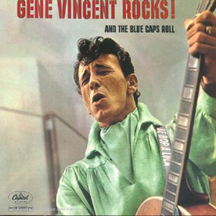GENE VINCENT 
As important as he is in his home country, the influence of Buddy Holly among British musicians is incalculable. Quoting Bruce Eder again: “The group’s heavy use of rhythm guitar slotted right in with the sound of skiffle music, a mix of blues, folk, country, and jazz elements that constituted most of British youth’s introduction to playing music and their way into rock & roll. Additionally, although he cut an exciting figure on-stage, Holly looked a lot less likely a rock & roll star than Elvis – tall, lanky, and bespectacled, he looked like an ordinary guy who simply played and sang well, and part of his appeal as a rock & roll star was rooted in how unlikely he looked in that role. He provided inspiration – and a way into the music – for tens of thousands of British teenagers who also couldn’t imagine themselves rivals to Elvis or Gene Vincent in the dark and dangerous department. . . . Additionally, although he played several different kinds of guitar, Holly was specifically responsible for popularizing – some would say elevating to mystical, even magical status – the Fender Stratocaster, especially in England.”
* * *
Ritchie Valens released just two 45’s but still showed incredible versatility. His first, “Come On, Let’s Go” is now regarded as a straight-up rock and roll classic, but it failed to chart. Writing in 1998, Billy Vera recalls “first hearing [“Come On, Let’s Go”] on Alan Freed’s TV Dance Party, a local New York equivalent of Dick Clark’s American Bandstand. It was a record which really grabbed my teenaged ears. I had never heard anything quite like it. It had a much ‘thicker’ sound than anything by Elvis, Chuck Berry, Gene Vincent, or even Eddie Cochran. For thickness, the only thing that came close was Bo Diddley.”
* * *
During the middle of a tour in late 1957 with Gene Vincent and Eddie Cochran, Little Richard had a series of visions – one of which turned out to be the launching of the first artificial satellite by the Soviet Union, Sputnik 1 – that convinced him to abandon his rock-and-roll life and go into the ministry. He shocked the world by announcing his conversion to Christianity while still a major star. He enrolled in a Bible College and formed the Little Richard Evangelistic Team in 1958.
(June 2013/1) * * *
Kim Fowley was a hustler first and foremost and would be a contender with James Brown as the Hardest Working Man in Show Business, at least among those (mostly) working behind the scenes. The Sun Herald obituary noted: “[Kim Fowley] went on to write or produce songs for a range of musicians, including the Byrds, the Beach Boys, Frank Zappa and the Mothers of Invention, Gene Vincent, Helen Reddy, and Warren Zevon” – but the article could just as easily have listed a different half-dozen prominent names.
(January 2015/1)
* * *
The only song on the Filthy Fifteen that I think deserves special attention is Cyndi Lauper’s “She Bop”. The conjugation of the made-up verb “bop” that forms most of the chorus is just another way of saying, “everybody’s doing it”; it also includes a reference to the 1957 Gene Vincent hit “Be-Bop-A-Lula”, presumably where the songwriters borrowed the word. (June 2016) |